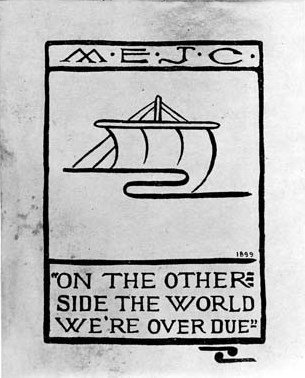Mary Colter, from Artist to Architect
In 1890, only twenty-two of the more than eight thousand architects in the U.S. were female, according to the U.S. Census—just 0.3 percent. In contrast, the occupation category “Artists and teachers of art” was 48 percent female. This was a significant percentage, especially since only about 17 percent of females over age ten were employed in any occupation in 1890.
Mary Elizabeth Jane Colter (1869 – 1959) was one of the women drawn to a career in art. After graduating from high school in 1888, Colter left St. Paul, Minnesota to attend the California School of Design in San Francisco. While studying art there, she also worked in an architecture firm. By spring 1892, Colter was supervising drawing at the Manual Training School in Menemonie, Wisconsin. ln November 1892, Colter returned to St. Paul when she got a position teaching freehand drawing at its manual training school. Her pay was $50 per month (about $1,600 in 2023 dollars).
Manual training schools were an outgrowth of the industrialization that created the need to train both skilled craftspeople and educated consumers to appreciate their goods. Students at these schools studied academic subjects for part of the day and drawing, drafting, furniture making, and other hands-on skills for the remainder of the school day. In addition to freehand drawing, Colter also taught literature.
Colter making a metal bowl, c. 1892. (Grand Canyon Museum Collection 16952)
As well as teaching art, giving public lectures about art, and helping to organize art exhibits, Colter created art. She received both local and national attention. A 1901 review of the Arts and Crafts Society exhibition in Minneapolis said, “Two beautiful copper bowls and an exceedingly novel leaden casket are the work of Miss Mary E. J. Colter of the St. Paul Mechanic Arts high school.” Colter’s exhibition of bookplates printed from an engraved metal plate earned mention in The Craftsman, a popular national magazine.
A bookplate designed by Colter, c. 1903. (Grand Canyon Museum Collection 13231).
Colter’s first freelance work with hospitality company Fred Harvey came as a result of her skill organizing art exhibitions and her interest in the art of Indigenous Peoples. In 1902, Colter was invited to travel to Albuquerque to help arrange baskets, pottery, rugs, and other objects crafted by Indigenous Peoples for sale at a Fred Harvey exhibit and retail building. There she met John Huckel, a Fred Harvey executive, and his wife Minnie, daughter of company founder Fred Harvey.
While Colter returned to St. Paul and her teaching job at the end of that summer, she continued to do small art-related projects for John Huckel and Fred Harvey on a freelance basis. In 1910, Huckel hired Colter full time. Her work for Fred Harvey over the next thirty-odd years included art, interior design, and architecture.
By 1940, the percentage of female architects had risen to 2.3 percent, according to the U.S. Census. That year, about 25 percent of females age 14 and older were in the paid labor force. Colter retired in 1944. Many of her designs have been lost to demolition or renovation, but her legacy remains. Her 1958 obituary in the Fred Harvey company magazine reads in part, “Miss Colter designed many of the principal Harvey establishments in the Southwest….These structures stand as a memorial to her great ability and devotion to the work. Some of her earlier buildings are generally credited with being the basis of and inspiration for the now prevalent Southwestern style of architecture.”
Sources:
Department of the Interior, “Table 78.” Eleventh Census [1890] - Volume 1. (Part I & Part II) Report on Population of the United States (Washington DC: U.S. Government Printing Office, 1895), 304.
M.E.J. Colter, untitled typescript autobiography, c. 1948-1958. Phoenix: Heard Museum Billie Jane Baguley Library and Archives.
“Social Functions,” The Saint Paul Daily Globe (April 3, 1892), 13.
The Saint Paul Daily Globe, “Proceedings of the Board of School Inspectors” (December 9, 1892), 7.
The Minneapolis Journal, “A Splendid Exhibit” (February 6, 1901), 6.
Katherine Louise Smith, “An arts and crafts exhibition at Minneapolis,” The Craftsman, Vol. III, No. 6 (March 1903), 375.
Bureau of the Census, U.S. Department of Commerce, “Table 58,” Sixteenth Census of the United States 1940, Population, Vol. III (Washington DC: U.S. Government Printing Office, 1943), 75.
Arnold Berke, Mary Colter: Architect of the Southwest. New York: Princeton Architectural Press, 2002.
“Miss Colter Dies in Santa Fe,” Fred Harvey Hospitality, January – February 1958: 3.

